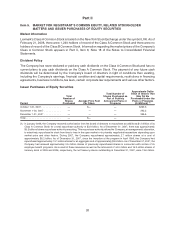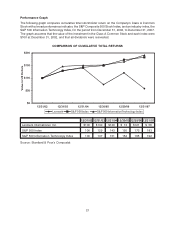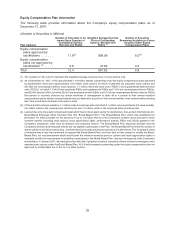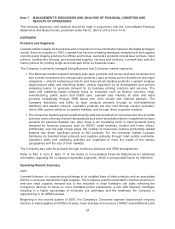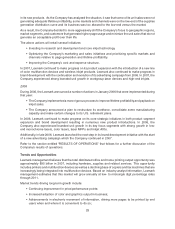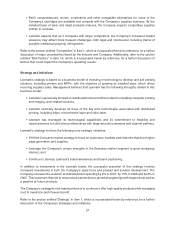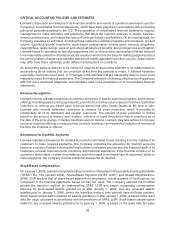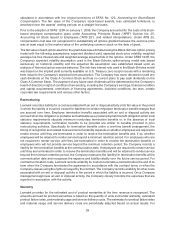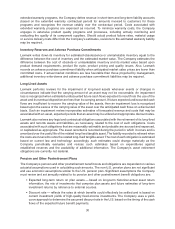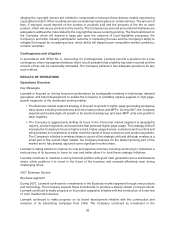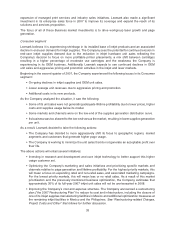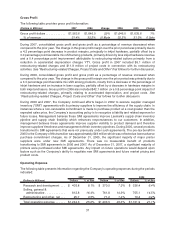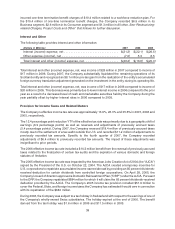Lexmark 2007 Annual Report Download - page 36
Download and view the complete annual report
Please find page 36 of the 2007 Lexmark annual report below. You can navigate through the pages in the report by either clicking on the pages listed below, or by using the keyword search tool below to find specific information within the annual report.extended warranty programs, the Company defers revenue in short-term and long-term liability accounts
(based on the extended warranty contractual period) for amounts invoiced to customers for these
programs and recognizes the revenue ratably over the contractual period. Costs associated with
extended warranty programs are expensed as incurred. To minimize warranty costs, the Company
engages in extensive product quality programs and processes, including actively monitoring and
evaluating the quality of its component suppliers. Should actual product failure rates, material usage
or service delivery costs differ from the Company’s estimates, revisions to the estimated warranty liability
may be required.
Inventory Reserves and Adverse Purchase Commitments
Lexmark writes down its inventory for estimated obsolescence or unmarketable inventory equal to the
difference between the cost of inventory and the estimated market value. The Company estimates the
difference between the cost of obsolete or unmarketable inventory and its market value based upon
product demand requirements, product life cycle, product pricing and quality issues. Also, Lexmark
records an adverse purchase commitment liability when anticipated market sales prices are lower than
committed costs. If actual market conditions are less favorable than those projected by management,
additional inventory write-downs and adverse purchase commitment liabilities may be required.
Long-Lived Assets
Lexmark performs reviews for the impairment of long-lived assets whenever events or changes in
circumstances indicate that the carrying amount of an asset may not be recoverable. An impairment
loss is recognized when estimated undiscounted future cash flows expected to result from the use of the
asset and its eventual disposition are less than its carrying amount. If future expected undiscounted cash
flows are insufficient to recover the carrying value of the assets, then an impairment loss is recognized
based upon the excess of the carrying value of the asset over the anticipated cash flows on a discounted
basis. Such an impairment review incorporates estimates of forecasted revenue and costs that may be
associated with an asset, expected periods that an asset may be utilized and appropriate discount rates.
Lexmark also reviews any legal and contractual obligations associated with the retirement of its long-lived
assets and records assets and liabilities, as necessary, related to the cost of such obligations. Costs
associated with such obligations that are reasonably estimable and probable are accrued and expensed,
or capitalized as appropriate. The asset recorded is recorded during the period in which it occurs and is
amortized over the useful life of the related long-lived tangible asset. The liability recorded is relieved when
the costs are incurred to retire the related long-lived tangible asset. The cost of each obligation is estimated
based on current law and technology; accordingly, such estimates could change materially as the
Company periodically evaluates and revises such estimates based on expenditures against
established reserves and the availability of additional information. The Company’s asset retirement
obligations are currently not material.
Pension and Other Postretirement Plans
The Company’s pension and other postretirement benefit costs and obligations are dependent on various
actuarial assumptions used in calculating such amounts. The non-U.S. pension plans are not significant
and use economic assumptions similar to the U.S. pension plan. Significant assumptions the Company
must review and set annually related to its pension and other postretirement benefit obligations are:
• Expected long-term return on plan assets — based on long-term historical actual asset return
information, the mix of investments that comprise plan assets and future estimates of long-term
investment returns by reference to external sources.
• Discount rate — reflects the rates at which benefits could effectively be settled and is based on
current investment yields of high-quality fixed-income investments. The Company uses a yield-
curve approach to determine the assumed discount rate in the U.S. based on the timing of the cash
flows of the expected future benefit payments.
30


